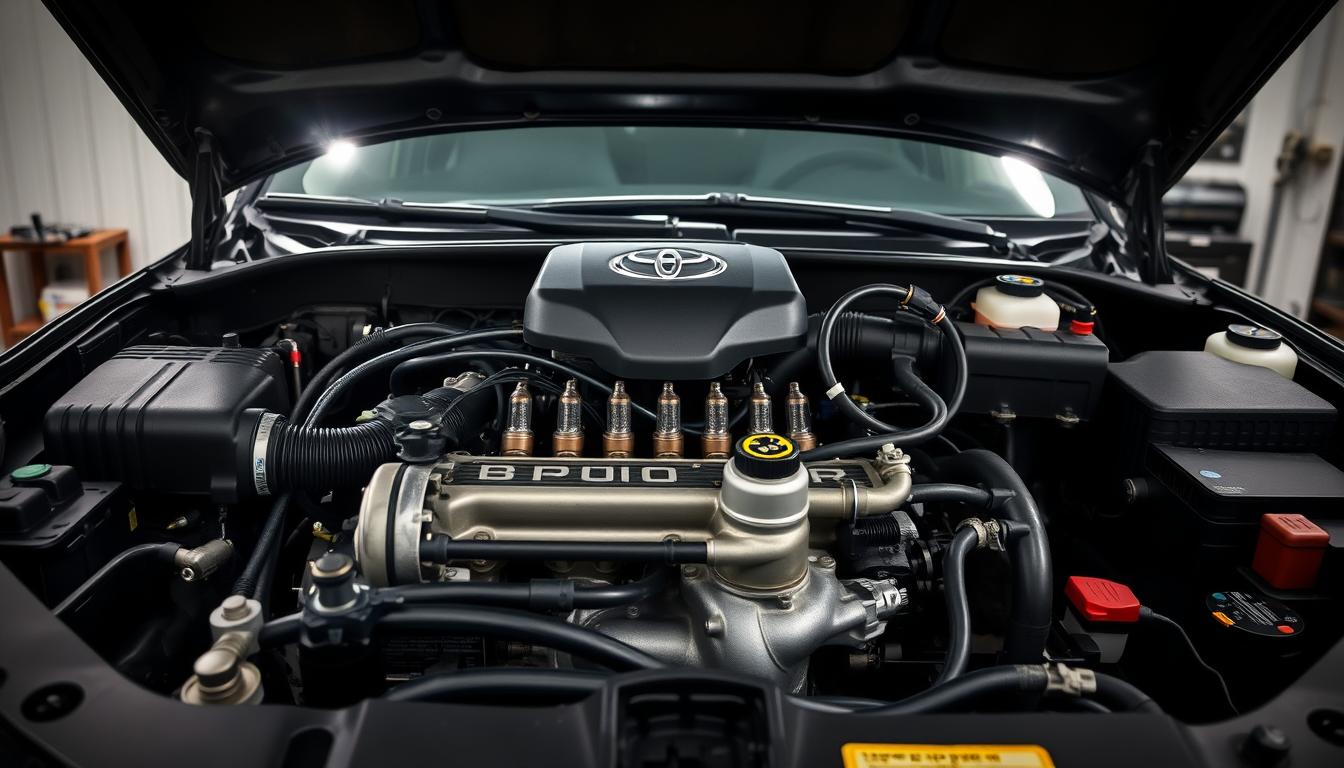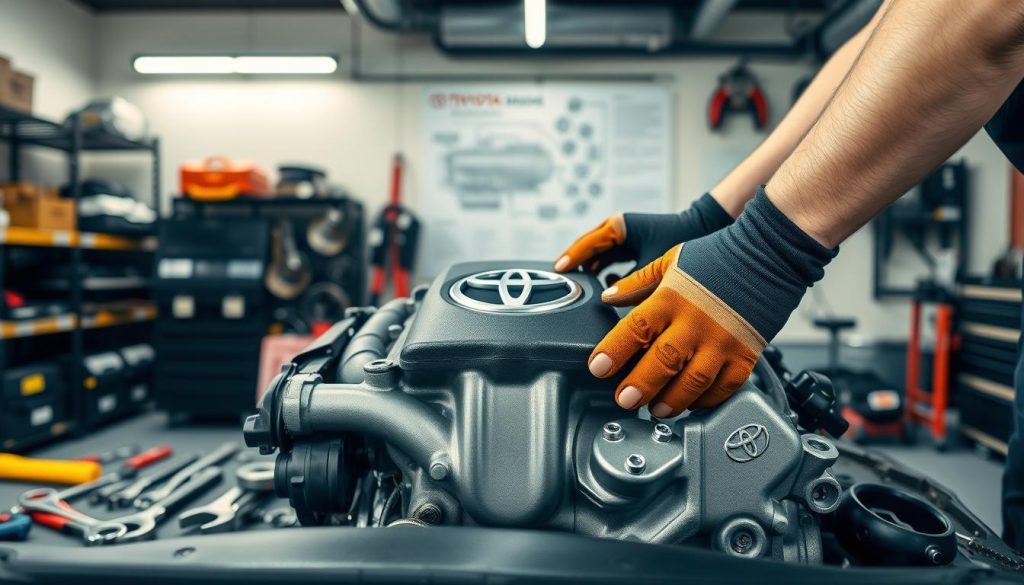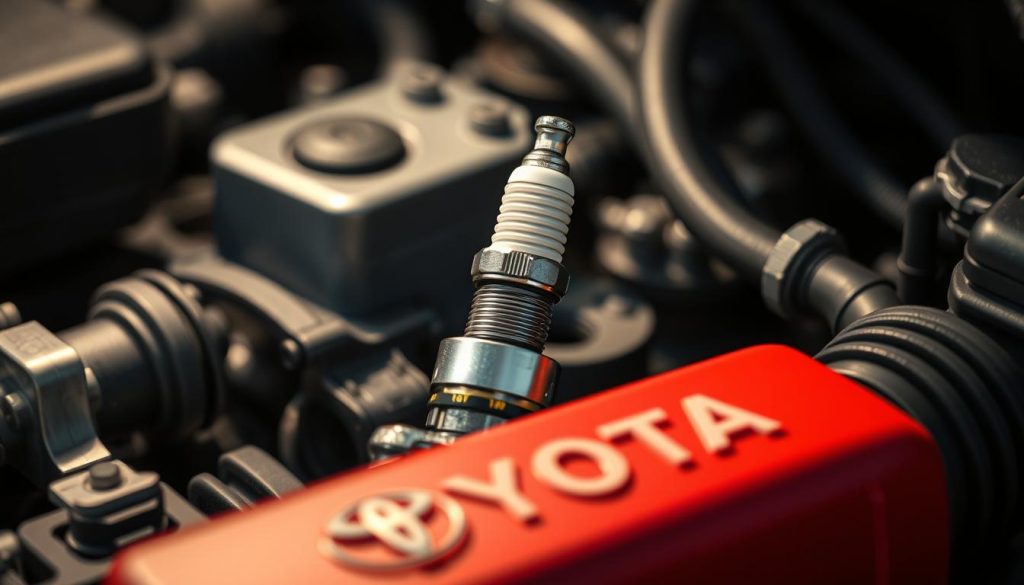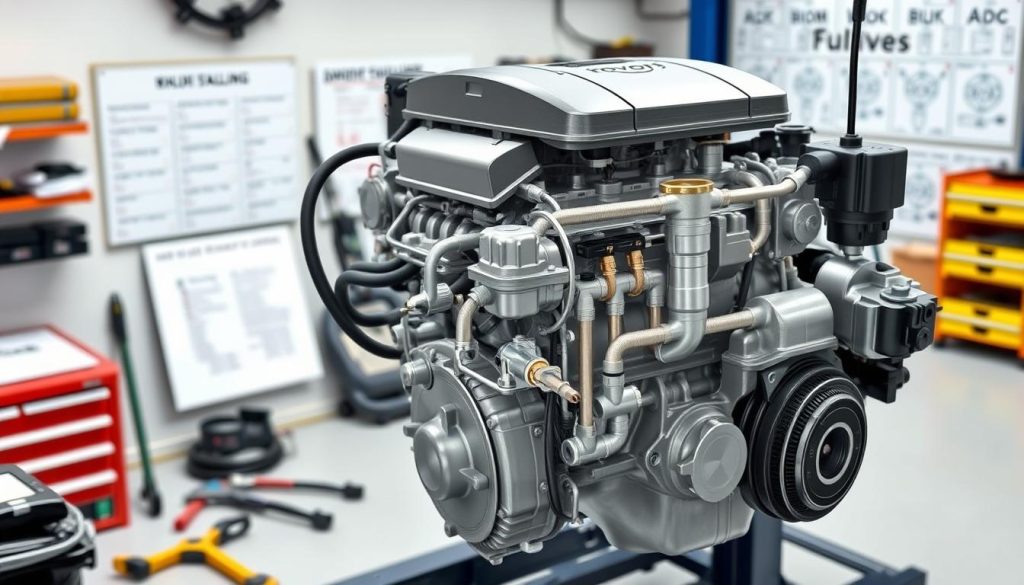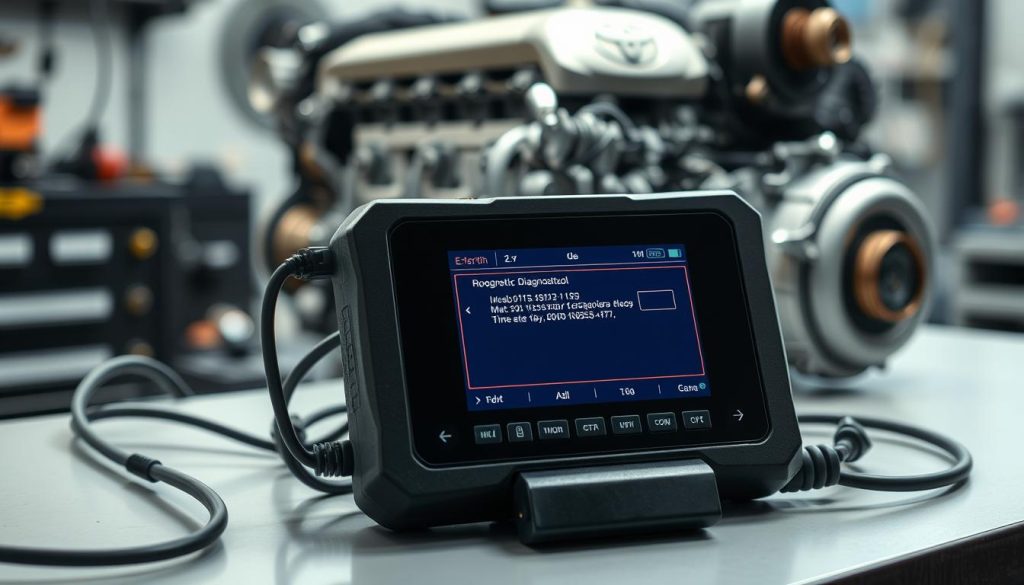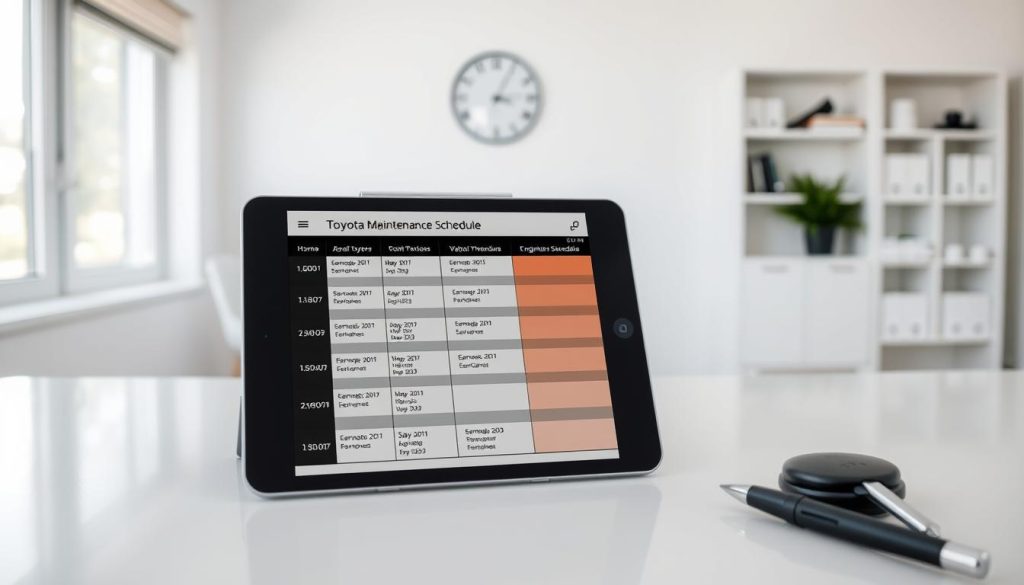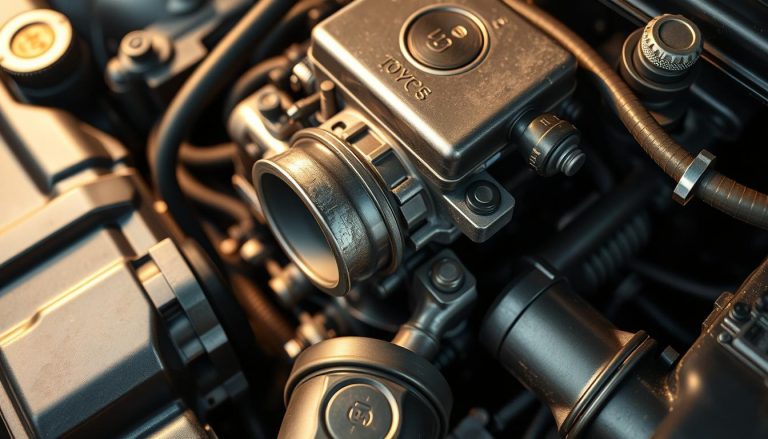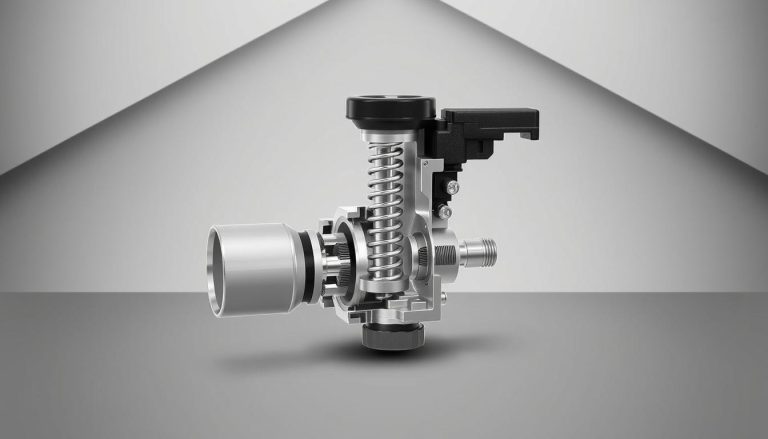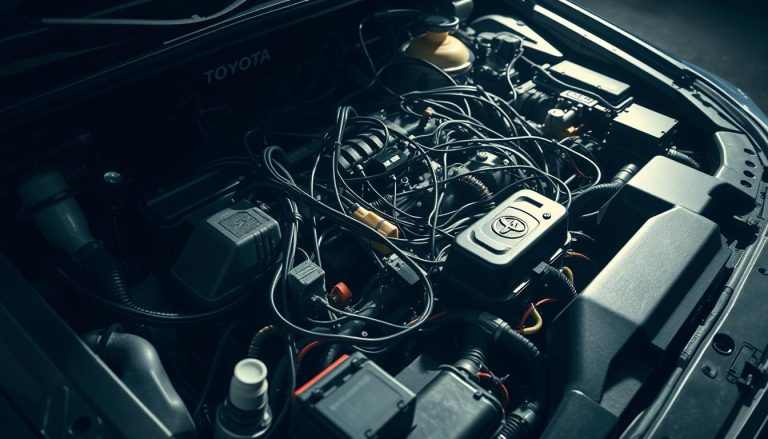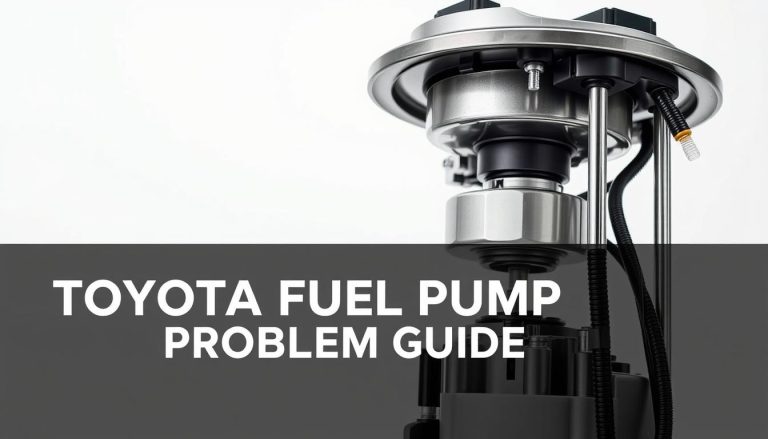Toyota Engine Stalling: Troubleshooting and Fixes
Nothing feels worse than your car suddenly losing power in traffic. Toyota engine stalling is a big safety risk and a major frustration for drivers. It can happen at red lights or on busy highways, and you need to act fast.
Many owners face this issue without warning. Your car might run fine one day and then not start the next. The good news? Most problems have easy fixes that don’t cost a lot.
This guide will help you find and fix power loss problems. We’ll look at common engine stalling causes and give you simple solutions. You’ll learn how to do basic checks and when to call a pro. You’ll feel confident in fixing this issue yourself.
Key Takeaways
- Many things can cause sudden power loss, like fuel or electrical issues
- Simple steps can help find the problem before you see a mechanic
- Regular maintenance can stop many power loss problems
- Always put safety first when your car suddenly stops
- For complex problems, you might need a pro’s help
- There are quick fixes for many basic issues
Understanding Toyota Engine Stalling Symptoms and Warning Signs
Toyota cars often stall gradually before they fail completely. Drivers notice small changes in their car’s behavior weeks or months before it stalls. Recognizing these early warning signs helps you fix problems before they get worse and keep you safe on the road.
Your Toyota might show signs like rough idling, hesitation when you accelerate, or vibrations in the steering wheel. Pay attention to these small changes in your car’s performance. They often mean there’s a problem that needs fixing right away.
Common Stalling Patterns in Toyota Vehicles
Different stalling patterns can tell you what’s wrong with your engine. Some Toyotas stall only when they’re cold, which might mean fuel system or sensor issues. Others stall when idling but run fine while driving, which could be a sign of an idle air control valve problem.
Stalling on highways is very dangerous and usually means big problems with fuel or ignition. Stalling without warning often means electrical or sensor problems.
| Stalling Pattern | Primary Symptoms | Urgency Level | Common Causes |
|---|---|---|---|
| Cold Start Stalling | Engine dies within minutes of starting | Medium | Fuel system, sensors |
| Idle Stalling | Stalls at traffic lights or parking | Medium | IAC valve, vacuum leaks |
| Highway Stalling | Sudden power loss while driving | High | Fuel pump, ignition system |
| Random Stalling | Unpredictable engine shutdown | High | Electrical issues, ECU problems |
When to Take Engine Stalling Seriously
Some engine stalling symptoms need quick help from a pro. Never ignore stalling at high speeds because it’s very dangerous. Also, stalling with strange noises, smells, or smoke needs fast checking.
Stalling often, even at slow speeds, means serious engine issues. If your Toyota stalls more than once a week, get it checked right away to avoid engine failure.
Dashboard Warning Lights and Error Codes
Modern Toyotas show important info through dashboard lights and codes. The check engine light often comes on before stalling. Don’t ignore this warning because it usually means a problem that can cause stalling.
Warning lights for the battery, oil pressure, and fuel system are key. Write down any error codes with an OBD-II scanner. These codes help mechanics find and fix problems fast.
Essential Safety Precautions Before Troubleshooting
Working on your Toyota’s engine needs careful safety steps from the start. Engine safety is key, no matter the problem. The right steps keep you and your car safe.
If your Toyota stalls while driving, get to safety first. Turn on your hazard lights. Move to the shoulder or a safe spot away from traffic.
Don’t try to fix it in a dangerous spot. Wait for help if you’re on a busy road or in bad weather.
Basic Safety Equipment and Workspace Setup
Get your workspace ready before starting. Make sure there’s good air flow, like in a garage. Carbon monoxide poisoning is a big risk with engines running.
Have a fire extinguisher ready for fuel system problems. Wear safety glasses and gloves to avoid burns and cuts. Use wheel chocks to keep your Toyota from moving.
| Safety Equipment | Purpose | When Required |
|---|---|---|
| Safety Glasses | Eye protection from debris | All diagnostic work |
| Work Gloves | Hand protection from heat/cuts | Engine component handling |
| Fire Extinguisher | Emergency fire suppression | Fuel system work |
| Wheel Chocks | Prevent vehicle movement | Under-hood diagnostics |
When to Seek Professional Help
Some problems need a pro right away. Fuel system problems like leaks or strong smells need a pro. Also, complex electrical or engine issues are too hard for DIY.
Call a pro if you smell gas, see fluid leaks, or see many warning lights. Your safety is more important than any repair cost.
Basic Diagnostic Tools You’ll Need
Using the right tools makes fixing engine problems easier. When your Toyota engine stalls, the right tools save time and money. Professional-grade tools help you find the exact cause instead of just treating symptoms.
Modern vehicles, like Toyotas, need specific tools for engine checks. Their computer systems require the right tools for accurate checks. The right tools make complex problems much easier to solve.
Essential Tools for Toyota Engine Diagnosis
Begin with basic tools like screwdrivers, wrenches, and pliers. A fuel pressure gauge tests the fuel system. Visual inspection tools like flashlights and mirrors show hidden engine problems.
A compression tester checks engine cylinders. Vacuum gauges find air leaks that cause stalling. These tools handle most basic checks well.
OBD-II Scanner Usage for Toyota Models
An OBD-II scanner connects to your Toyota’s diagnostic port. These devices read error codes from the engine computer system, showing ignition and sensor issues. Choose scanners that work with Toyota codes for the best results.
Advanced scanners show live data from engine sensors. This helps find intermittent stalling problems. Quality scanners pay for themselves quickly through accurate diagnostics.
Multimeter and Basic Testing Equipment
A digital multimeter tests electrical parts in your Toyota’s engine. It checks sensor voltages, ground connections, and circuit continuity. Electrical problems often cause mysterious stalling issues that multimeters can find.
Test lights and wire probes help find electrical problems fast. These tools work with multimeters for detailed electrical system checks. Proper electrical testing avoids unnecessary part replacement.
Step 1: Checking Your Toyota’s Fuel System
Fuel delivery problems are a big reason for Toyota engine stalls. It’s key to check your Toyota’s fuel system well. Your engine needs clean fuel at the right pressure to run smoothly. If any part of this system fails, your engine might stall.
First, learn how each part of the fuel system affects your engine. A methodical check saves time and avoids wrong part swaps. Fuel pump issues and filter problems show up differently, needing special tests to find the problem.
Inspecting Fuel Pump Performance
Listen for the fuel pump’s sound when you turn the key. A two-second whir means it’s working. No sound means it’s not working or has electrical issues.
Have someone turn the ignition while you listen near the fuel tank. A good pump hums steadily. Odd sounds or grinding mean the pump is damaged.
Testing Fuel Pressure and Flow
Use a fuel pressure gauge on your Toyota’s test port. Most engines need 38-44 PSI at idle. Low pressure means pump or filter problems.
Do a fuel flow test by taking off the fuel line and measuring flow. Your pump should flow about one quart per minute. Low flow causes stalling when you accelerate or load up.
Examining Fuel Filter Condition
Look for damage, rust, or dirt on your fuel filter. Change it every 30,000-40,000 miles or as your Toyota’s manual says. A clogged filter blocks fuel flow and lowers pressure.
Take out the filter and check the screen for debris. Dark fuel or metal particles mean bigger problems inside the system.
Fuel Injector Cleaning and Testing
Use a digital multimeter to test fuel injectors. Toyota injectors should show 12-16 ohms. If they don’t, they need to be replaced.
Clean injectors with special solutions or ultrasonic cleaning. Clogged injectors lead to uneven fuel and bad idle. Unlike air intake problems, injector issues cause specific misfires, not overall engine trouble.
Step 2: Diagnosing Air Intake Problems
When your Toyota stalls without warning, the air intake system is often the culprit. It affects the balance between air and fuel needed for smooth engine operation. Proper airflow is essential to prevent stalling, which is common during acceleration or when the engine is under heavy load.
The air intake system has several key components that must work together. Regular checks and maintenance of these parts can stop many stalling problems before they start.
Mass Airflow Sensor Testing and Cleaning
The mass airflow sensor measures air intake and helps the engine computer adjust the fuel mix. A dirty or faulty sensor can lead to stalling issues. Testing this sensor involves using an OBD-II scanner to look for error codes.
To clean the sensor, use a MAF cleaner spray. Remove it carefully and spray the wire parts gently. Let it dry fully before putting it back. Never use compressed air or touch the sensing elements with your fingers.
Air Filter Inspection and Replacement
A clogged air filter limits airflow and can cause stalling when accelerating. Take out the air filter and check if light can pass through. If not, it’s time for a new one.
Swap the filter with a high-quality OEM or similar part. Proper installation is key to keep unfiltered air out of your engine. Also, clean the filter housing before installing the new filter.
Throttle Body Cleaning Procedures
Carbon buildup in the throttle body can mess with airflow control. Remove the air intake hose and look for buildup on the throttle plate. Use throttle body cleaner and a soft brush to clean it.
While cleaning, move the throttle plate by hand to reach all areas. Be gentle to avoid damaging the throttle position sensor. Put everything back together carefully and reset the idle learn procedure if needed.
| Component | Testing Method | Common Issues | Replacement Interval |
|---|---|---|---|
| Mass Airflow Sensor | OBD-II scan, visual inspection | Contamination, wire damage | 100,000-150,000 miles |
| Air Filter | Visual inspection, light test | Clogging, oil contamination | 12,000-15,000 miles |
| Throttle Body | Visual inspection, operation test | Carbon buildup, sticking | Clean every 30,000 miles |
| Intake Hoses | Visual inspection, squeeze test | Cracks, loose connections | As needed |
Step 3: Evaluating Ignition System Components
Understanding your Toyota’s ignition parts helps find why your engine stalls. The ignition system makes the spark that ignites your fuel at the right time. If these parts fail, your engine might stall or have trouble staying at idle.
A bad ignition system can be tricky to diagnose because it works sometimes. Stalling might happen more when the engine is warm or under certain driving conditions. These signs can tell you which parts need fixing.
Spark Plug Inspection and Testing
Begin by taking out and checking each spark plug. Healthy spark plugs have light brown or tan deposits on the electrodes. Black, oily deposits mean too much fuel, while white or blistered electrodes point to overheating.
Use a feeler gauge to check the spark plug gap. Toyota engines need gaps between 0.028 to 0.044 inches, depending on the model year. If gaps are too wide, spark plugs are worn out and need replacement.
Ignition Coil Performance Check
Modern Toyotas use individual coils or coil packs. Test each coil’s resistance with a multimeter, comparing it to your manual’s specs. Coils with unusual resistance often cause stalling and misfiring.
Swap suspected coils with known good ones to confirm the problem. If the issue moves to another cylinder, you need to replace the coil. Faulty coils might work when cold but fail as the engine warms up.
Distributor Cap and Rotor Examination
Older Toyotas with distributors need cap and rotor checks. Look for carbon tracking, cracks, or corrosion on the cap’s inside. Moisture and carbon buildup can prevent proper ignition.
| Component | Normal Condition | Replace When | Stalling Symptoms |
|---|---|---|---|
| Spark Plugs | Light brown deposits | Gap exceeds 0.050″ | Rough idle, misfiring |
| Ignition Coils | Within resistance specs | Open or shorted windings | Intermittent stalling |
| Distributor Cap | Clean, no cracks | Carbon tracking present | Wet weather stalling |
| Rotor | Sharp contact point | Burned or worn tip | High RPM misfiring |
Remember, ignition problems can affect other systems too. A failing idle air control valve might hide ignition issues by adjusting for poor combustion. Fixing ignition system problems first is key before moving on to other steps.
Most Common Causes of Toyota Engine Stalling
Most Toyota stalling issues come from three main areas. Knowing these common causes helps you find the problem faster. This saves time and money when fixing your car.
Each area shows different signs. Fuel system problems grow slowly. Electrical issues pop up at random. Sensor failures make the engine act strangely and get worse over time.
Fuel System Related Stalling Issues
Fuel delivery issues are the top reason for stalling. A clogged fuel filter slows down fuel flow, leading to stalling. Failing fuel pumps also cause stalling and make a whining sound.
Dirty fuel injectors mess up the fuel spray pattern. This leads to rough idling and stalling. Keeping your fuel system clean helps avoid these problems.
Vacuum leaks in the fuel system cause stalling. These leaks happen at rubber parts that wear out over time.
Electrical System Malfunctions
Electrical problems are frustrating because they’re not always there. A weak battery or failing alternator messes with the engine computer. You might see dim lights or radio issues too.
Corroded battery terminals and loose connections stop power to important parts. These issues get worse in cold weather. Clean connections and checking voltage can quickly find the cause.
Engine Sensor Failures and Symptoms
Modern Toyota engines need many sensors to work right. The mass airflow sensor tells the computer how much fuel to use. If it fails, the engine gets the wrong fuel mix.
Crankshaft position sensors keep engine timing right. They can cause sudden stalling. Throttle position sensors affect how well the engine idles and accelerates. These sensors often light up the dashboard to show the problem.
Fixing Idle Air Control Valve Problems
A bad Idle Air Control Valve can make stopping your car a hassle. This small part helps control airflow when your engine is idling. It stops your car from stalling at lights and stops.
Over time, the IAC valve gets dirty with carbon and grime. This dirt makes it hard for the valve to work right. Soon, your car might stall suddenly, leaving you stuck.
Finding Your IAC Valve Location
Toyota puts the IAC valve in different spots, depending on the engine and year. It’s usually on the throttle body. Look for a small part with wires and vacuum hoses.
In older Camrys, the valve is on the throttle body’s side. Newer ones might have it inside the throttle body. Always check your owner’s manual for where it is in your car.
Cleaning Your IAC Valve Step-by-Step
First, disconnect the battery and remove the air intake tube. Then, unplug the electrical connector and take out the screws holding the valve. Use a throttle body cleaning solution for this.
Soak the valve with cleaning solution and use a soft brush to clean it. Be gentle to avoid damaging it. Let it dry completely before putting it back.
When Replacement Becomes Necessary
At times, cleaning won’t fix the problem. Look for signs like stalling after cleaning, damage to the valve, or error codes. These mean you might need a new one.
| Symptom | Clean First | Replace Needed | Cost Range |
|---|---|---|---|
| Occasional stalling | Yes | Rarely | $15-25 |
| Frequent stalling | Yes | Sometimes | $80-150 |
| Constant rough idle | Try first | Usually | $120-200 |
| Check engine light | Yes | Often | $100-180 |
After putting in a new IAC valve, some Toyotas need an idle relearn. This means running the engine through special cycles to adjust to the new part.
Resolving Toyota Engine Sensor Malfunctions
Sensor malfunctions are a big problem for Toyota engines. They need many sensors to run smoothly. If these sensors fail, your engine might stall or run rough.
Knowing which sensors are most important helps you fix problems faster. The crankshaft, camshaft, and oxygen sensors are key. They help prevent Toyota Corolla stalling and other issues.
Identifying Faulty Crankshaft Position Sensors
The crankshaft position sensor is vital for your engine’s timing. If it fails, your Toyota might stall suddenly, often when you accelerate or idle. You might notice stalling more often over time.
To test it, you’ll need a multimeter and some electrical knowledge. Check the sensor’s resistance against Toyota’s standards. It should be between 500-1500 ohms. If it’s not, the sensor is bad.
To replace it, find the sensor near the crankshaft pulley or flywheel. Always disconnect the battery first. Remove the electrical connector, then the sensor. Install the new one with the same gap as the old one.
Diagnosing Camshaft Position Sensor Issues
Camshaft sensor problems start with rough idling and can lead to stalling. These sensors are key for the engine’s computer to set valve timing.
Toyota uses magnetic and Hall-effect sensors, depending on the model year. Testing them involves checking voltage signals while the engine is running. A good sensor will show consistent voltage pulses.
Look out for these symptoms:
- Hard starting, often when the engine is warm
- Rough idle that gets better at higher RPMs
- Stalling at low speeds
- Check engine light with timing-related codes
Testing and Replacing Oxygen Sensors
Oxygen sensors don’t usually cause stalling, but bad ones can lead to it. They check exhaust gases to keep the fuel mix right.
Use an OBD-II scanner to check the sensor’s data while the engine is running. Good sensors will switch between rich and lean readings often. If they don’t, or if they stay the same, they need to be replaced.
Most Toyotas have several oxygen sensors. Replace them one at a time to avoid mistakes. Always use Toyota-approved sensors for the best fit and function. Generic sensors might not work right, even if they seem okay at first.
Addressing Vacuum Leak Detection and Repair
When your Toyota RAV4 stalling is unpredictable, vacuum leaks might be the cause. These air leaks upset the engine’s air and fuel balance. This leads to erratic idling, sudden stalling, and performance issues.
Vacuum leaks let extra air into your engine. This confuses the engine’s computer. Your Toyota tries to adjust fuel delivery, but this often causes more problems.
Identifying Problem Areas in Your Engine Bay
Toyota engines have common spots for vacuum leaks. The intake manifold gasket is the most serious. When it fails, a lot of unmetered air gets in.
Vacuum hoses get brittle with age and heat. They crack and split, mainly at connection points. The PCV system also leaks when valves stick or hoses deteriorate.
Brake booster connections often leak in older Toyotas. The vacuum line to the brake booster can crack or become loose.
Professional and DIY Testing Approaches
Vacuum leak detection needs systematic testing. Professional smoke testing uses artificial smoke in the vacuum system. This makes small leaks visible as smoke escapes.
DIY methods include using carburetor cleaner or propane around suspected leaks. If the engine RPM changes after spraying, you’ve found the leak.
Effective Repair Strategies
Replacing vacuum hoses fixes most leaks quickly and cheaply. Cut damaged sections and install new hose with proper clamps.
Replacing intake manifold gaskets is more complex. It requires skill, time, and special tools. Pay close attention to torque specifications.
| Leak Type | Difficulty Level | Repair Cost | Time Required |
|---|---|---|---|
| Vacuum Hose | Easy | $5-15 | 15-30 minutes |
| PCV Valve | Moderate | $10-25 | 30-45 minutes |
| Intake Manifold Gasket | Advanced | $150-400 | 3-5 hours |
| Brake Booster Line | Moderate | $20-50 | 45-60 minutes |
Toyota-Specific Stalling Issues by Popular Models
Different Toyota models face unique stalling problems. Knowing these helps you target the right areas to check. Each car has its own set of common issues that mechanics quickly spot.
Toyota Camry Stalling Problems and Solutions
Toyota Camry stalling often comes from specific weaknesses in each generation. Older V6 models often have intake manifold gasket failures that cause vacuum leaks. These leaks mess up the air-fuel mix, leading to bad idling.
Four-cylinder Camry engines often get carbon buildup in the intake. This blocks airflow and causes stalling. The 2007-2011 models also have oil consumption issues that foul oxygen sensors and cause carbon deposits.
Keeping the intake clean and changing oil on time can solve most Camry stalling problems. Also, replace the PCV valve every 60,000 miles to cut down oil consumption.
Toyota Corolla Common Stalling Issues
Toyota Corolla stalling often comes from the idle air control system and carbon buildup in the throttle body. High-mileage Corollas with neglected maintenance show these problems a lot.
The throttle body needs cleaning every 30,000 miles to avoid carbon buildup. A dirty throttle body leads to unstable idle speeds and stalling when stopping. The idle air control valve also needs cleaning to keep airflow right at idle.
Contamination of the mass airflow sensor is a big issue for Corolla engines. Clean or replace this sensor if you see stalling and rough acceleration.
Toyota RAV4 and Highlander Specific Concerns
Toyota Highlander stalling often comes from its complex all-wheel-drive system and bigger engine. These SUVs might have problems with the transmission control module that affect engine performance during shifts.
Finding the fuel pump in RAV4 and Highlander models is hard because of their design. The high engines cause unique sensor failures, like crankshaft position sensors, due to more heat and vibration.
Regularly check the engine control module connections in these models. Corrosion in these connections can cause stalling that’s hard to find.
Toyota Prius Hybrid System Stalling
Toyota Prius stalling is a unique challenge because of the complex mix of gasoline and electric systems. What looks like engine stalling might actually be a hybrid battery or inverter problem.
The hybrid control module manages both power sources, and its failure can cause stalling. Problems with the battery cooling system can also make the Prius shut down suddenly, looking like engine stalling.
Traditional engine checks don’t work for hybrid system issues. Expertise in hybrid systems is key for fixing Prius stalling problems. Don’t spend time on usual checks when hybrid parts are likely the problem.
Advanced Troubleshooting for Persistent Stalling Problems
When Toyota engine stalling doesn’t stop after basic fixes, you need advanced troubleshooting. These tough issues involve many systems working together. This makes them hard to find and fix.
Using professional diagnostic methods can solve stubborn problems. Knowing these techniques saves time and avoids replacing parts unnecessarily.
ECU and Engine Computer System Diagnostics
ECU diagnostics need special tools to check how your engine’s computer works. Modern Toyotas use complex software for fuel, ignition, and emissions control.
Advanced scan tools can show live data from your engine’s computer. They display sensor readings in real-time. This helps find intermittent faults that cause stalling.
“Engine Control Module failure accounts for approximately 15% of persistent stalling cases that resist basic troubleshooting methods.”
Look at freeze frame data when trouble codes appear. This data captures sensor readings at the exact moment of a problem. It gives clues for diagnosis.
Timing Belt and Chain Inspection
Timing problems cause stalling if valve timing is off. Listen carefully for odd noises during engine use.
Visual checks show timing belt damage or wear. Timing chains can stretch, causing issues without failing completely.
Use a timing light to check timing marks alignment. Wrong timing harms engine performance and can stall it at idle or under load.
Internal Engine Problems Assessment
Internal engine issues need compression and leak-down tests. These tests show valve guide wear, piston damage, or cylinder head problems that affect vacuum.
Do a vacuum test with a gauge on the intake manifold. Steady readings mean healthy parts. Fluctuating readings point to internal problems.
Preventive maintenance helps avoid internal engine issues. Regular oil changes and quality fuel prevent carbon buildup. This stops valve sticking and compression loss.
Get a professional evaluation if many symptoms appear together. Complex internal problems might need machine shop services or a new engine.
Preventive Maintenance to Avoid Future Engine Stalling
Smart maintenance can stop Toyota engine stalling problems before they start. Being proactive saves time, money, and avoids the hassle of unexpected breakdowns. Prevention is cheaper than emergency repairs and keeps your Toyota running well for years.
Your Toyota’s engine needs clean fuel, fresh air, and right ignition timing to run well. Regular maintenance prevents deposits and wear that cause stalling.
Regular Service Schedule for Toyota Engines
Following a detailed maintenance schedule protects your engine from stalling issues. Basic oil changes aren’t enough – your Toyota needs regular care of all engine systems.
Change air filters every 12,000 miles or yearly. Clean fuel injectors every 30,000 miles to avoid clogs. Check spark plugs at 60,000-mile intervals for best ignition.
| Service Item | City Driving | Highway Driving | Severe Conditions |
|---|---|---|---|
| Oil Change | 5,000 miles | 7,500 miles | 3,000 miles |
| Air Filter | 10,000 miles | 12,000 miles | 8,000 miles |
| Fuel Filter | 25,000 miles | 30,000 miles | 20,000 miles |
| Spark Plugs | 60,000 miles | 60,000 miles | 45,000 miles |
Quality Fuel and Oil Recommendations
Top Tier gasoline prevents fuel system deposits that cause stalling. These certified fuels have cleaning additives for injectors and intake valves.
Use the oil viscosity recommended by your Toyota model. High-quality synthetic oils last longer and prevent breakdowns. Change oil before it breaks down to avoid costly repairs.
Seasonal Maintenance Considerations
Winter preparation stops cold-weather stalling. Add fuel system antifreeze to prevent ice in fuel lines. Check battery connections and charging system before cold weather hits.
Summer maintenance focuses on cooling system health and fuel vapor management. Hot weather stressing can trigger stalling if cooling systems aren’t maintained. Replace coolant as recommended and inspect hoses for heat damage.
Conclusion
Engine troubleshooting doesn’t have to feel overwhelming. By following a systematic approach, you can tackle stalling issues with confidence. This guide has shown you each step, from basic safety checks to advanced diagnostic techniques.
Your Toyota’s reliability comes from proper care and attention to warning signs. Quick action on unusual symptoms prevents major repairs. The methods we’ve covered save time and money.
Safety is always the first priority. Whether your engine stalls on a busy highway or you’re working under the hood, precautions protect you and others. Keep your diagnostic tools ready and maintain a clean workspace for effective troubleshooting.
Regular maintenance and quality parts keep your Toyota running smoothly for years. Preventive strategies outlined here help avoid unexpected breakdowns. When complex issues arise, professional mechanics have the right equipment for advanced repairs.
Your Toyota can deliver dependable service when you stay proactive about its care. Apply these troubleshooting techniques as needed, but don’t wait for problems to worsen. With the right approach, you’ll enjoy many more miles of reliable driving ahead.
FAQ
Why does my Toyota stall at idle but run fine while driving?
A problem with the Idle Air Control Valve (IAC) or a vacuum leak might be the cause. The IAC valve controls airflow when the throttle is closed. Carbon buildup or valve failure can prevent proper idle air regulation. Vacuum leaks also affect idle more than driving conditions because the engine relies more heavily on precise air control at idle. Start by cleaning the IAC valve and checking for loose vacuum hoses around the intake manifold.
What should I do if my Toyota stalls while driving on the highway?
Immediately turn on your hazard lights, safely move to the shoulder or emergency lane, and turn off the engine. Wait a few minutes before attempting to restart. If the engine restarts and runs normally, drive carefully to the nearest service station. Highway stalling often indicates fuel pump failure, crankshaft position sensor problems, or severe overheating. This is a serious safety issue that requires immediate professional diagnosis.
How can I tell if my Toyota’s fuel pump is failing and causing stalling?
Listen for the fuel pump’s characteristic whirring sound for 2-3 seconds when you first turn the key to the “on” position (before starting). A failing pump may be silent or make unusual noises. Other symptoms include stalling during acceleration, difficulty starting (when the tank is low), and engine hesitation under load. You can also test fuel pressure using a fuel pressure gauge – Toyota engines typically require 40-60 PSI depending on the model.
Can a dirty air filter cause my Toyota to stall?
Yes, a severely clogged air filter can restrict airflow enough to cause stalling, mainly during acceleration or under load. But, air filter restriction usually causes gradual performance loss before complete stalling occurs. If your Toyota stalls suddenly with a dirty air filter, there’s likely an additional problem such as a mass airflow sensor malfunction or fuel system issue. Replace the air filter first, as it’s inexpensive and may resolve multiple performance issues.
What does it mean when my Toyota stalls and the check engine light comes on?
The check engine light indicates the engine management system has detected a problem and stored diagnostic trouble codes. Use an OBD-II scanner to retrieve these codes, which will point you toward specific system failures. Common codes related to stalling include P0171/P0174 (lean fuel mixture), P0340 (camshaft position sensor), P0335 (crankshaft position sensor), and P0506 (idle air control). These codes provide valuable diagnostic direction and should be addressed promptly.
Is it safe to drive my Toyota if it’s stalling intermittently?
No, intermittent stalling creates serious safety risks, even if the engine restarts immediately. The underlying problem will likely worsen and could leave you stranded in dangerous situations. Intermittent stalling often indicates failing sensors, fuel system problems, or electrical issues that can progress to complete failure without warning. Have your Toyota diagnosed immediately and avoid driving except to reach a repair facility.
Why does my Toyota only stall when it’s cold?
Cold stalling typically relates to fuel system or sensor issues that affect cold engine operation. Common causes include a failing coolant temperature sensor, fuel injectors that don’t atomize fuel properly when cold, or carbon buildup in the intake system. The idle air control valve may also stick when cold due to oil or carbon deposits. These problems often resolve as the engine warms up but require attention to prevent worsening.
Can bad spark plugs cause my Toyota to stall?
Yes, worn or fouled spark plugs can cause misfiring that leads to stalling, mainly at idle or low speeds. Spark plug problems usually cause noticeable rough running, hesitation, and reduced power before complete stalling occurs. If your Toyota stalls suddenly without prior symptoms, the problem is more likely related to fuel delivery, sensors, or electrical systems. Replace spark plugs if they’re overdue for service, but don’t expect this alone to solve sudden stalling issues.
How do I know if my Toyota’s mass airflow sensor is causing stalling problems?
A failing mass airflow sensor (MAF) typically causes rough idling, hesitation during acceleration, and eventually stalling as the engine computer receives incorrect airflow information. You can test the MAF by disconnecting it while the engine runs – if performance improves, the sensor is likely faulty. Clean the MAF sensor with specialized cleaner first, as contamination is common. MAF problems often trigger check engine codes P0100-P0104, which help confirm the diagnosis.
What’s the difference between stalling caused by fuel problems versus electrical problems?
Fuel-related stalling often occurs during acceleration, climbing hills, or when the fuel tank is low, and may be accompanied by engine hesitation or surging. Electrical stalling tends to be more sudden and complete, often occurring randomly without relation to driving conditions. Electrical problems may coincide with dimming lights, radio cutting out, or dashboard warning lights. Fuel issues usually develop gradually, while electrical failures can happen instantly without warning.
Can I clean my Toyota’s throttle body myself to fix stalling issues?
Yes, throttle body cleaning is a straightforward DIY maintenance task that can resolve stalling caused by carbon buildup. Remove the air intake duct, spray the throttle plate and bore with throttle body cleaner, and wipe clean with a cloth. Never force the throttle plate open on electronic throttle bodies, as this can damage the motor. After cleaning, you may need to perform an idle relearn procedure by letting the engine idle for 10-15 minutes. This maintenance should be done every 30,000-50,000 miles.
Why does my Toyota Prius stall differently than regular Toyota models?
Toyota Prius hybrid vehicles have complex interactions between the gasoline engine and electric motor systems. What appears to be engine stalling may actually be hybrid system faults involving the battery pack, inverter, or hybrid control modules. The gasoline engine may shut off normally as part of hybrid operation, but system faults can prevent proper restart. Prius stalling issues require hybrid-specific diagnostic equipment and expertise, making professional diagnosis essential for these models.
How often should I replace my Toyota’s fuel filter to prevent stalling?
Most Toyota models have fuel filters integrated into the fuel pump assembly inside the tank, designed to last 100,000+ miles. If your Toyota has an external fuel filter (common in older models), replace it every 30,000-40,000 miles or according to the maintenance schedule. Clogged fuel filters cause stalling during acceleration or under load as fuel demand increases. If you suspect fuel filter problems, also consider fuel quality – contaminated fuel can clog filters prematurely.
What should I check first when my Toyota starts stalling after recent maintenance?
First, verify that all connections disturbed during maintenance are properly secured, including air intake ducts, vacuum hoses, and electrical connectors. Check that the mass airflow sensor connector is clean and tight, as this is commonly disturbed during air filter replacement. Ensure the correct parts were installed and that no tools or debris were left in the engine bay. If the problem started immediately after maintenance, it’s likely related to something that was disconnected or incorrectly reassembled during the service.
Can using low-quality gasoline cause my Toyota to stall?
Yes, poor-quality fuel can cause stalling through several mechanisms. Low-octane fuel can cause knock and timing retardation that affects performance. Contaminated fuel with water or debris can clog injectors and fuel filters. Fuel without adequate detergent additives allows carbon deposits to build up in the intake system and on valves. Use Top Tier gasoline brands that meet enhanced detergent standards, and consider fuel system cleaning if you’ve been using questionable fuel sources. Water contamination is problematic and may require fuel system draining.

